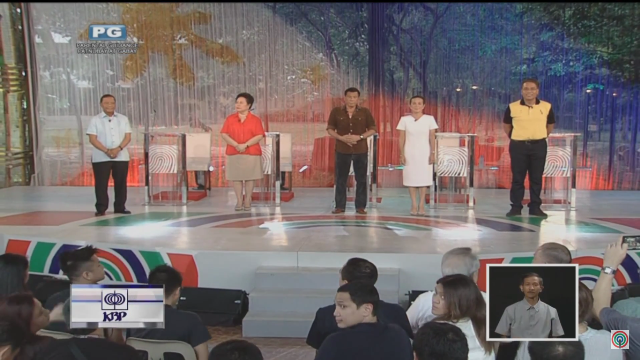Sober Conclusion to the Presidential Debates
THE THIRD and last presidential debate organized by the Commission on Elections (Comelec) was the sober conclusion of the PiliPinas Debates 2016 series, with less personal attacks and bickering among the candidates who, this time, were more focused on presenting their plans and platforms.
The debate hosted by ABS-CBN used a town hall format, in which selected members of the audience asked the candidates questions related to the concerns of their sectors, among them commuters, fisherfolk, contractual workers, overseas Filipino workers (OFWs) and Moros.
The audience asked candidates to address among the most serious public concerns: the West Philippine Sea Dispute, the traffic problem in Manila and other cities, contractualization and job security, the plight of OFWs, health care, and peace in Mindanao. For each of these issues, short videos of interviews with real-life persons narrating their day-to-day problems were shown. The same people, who were among the debate’s live audience, then addressed the candidates directly and asked them how they intend to solve the problems of their respective sectors.
Each of the presidential aspirants was given two minutes to answer each question, and 30 more seconds to add to and/or elaborate on their answers. Since the candidates faced the voting public, the town hall strategy elicited substantive answers from most of the candidates, some of them had clearly given these issues thought and time. Along with stock answers, responses revealed personal characteristics of each candidate, such as, for example, the tendency of Mayor Rodrigo Duterte to trivialize serious questions. For instance, he refused to answer how his campaign is being financed by replying, rather flippantly, that his financier is a person he called “Emilio Aguinaldo.” Asked about the dispute in the West Philippine Sea, he and Senator Miriam Defensor Santiago played to the gallery; the former claiming he would jet-ski to Chinese-controlled islands and plant a flag there, and the latter declaring she would order the bombing of Chinese occupants.
While this format allows the candidate to just spin around statements cut out of briefing documents, ABS-CBN can be commended for involving real people who gave a human face to some of the country’s most critical and persistent problems. It recalled, for those who first saw this employed in the 1992 presidential race, the personification of public need in Mang Pandoy, who many years later was still being cited for having imprinted his point in the media narrative of that election.
Perhaps the most interesting part of the debate was the “fast talk” segment, during which moderators Karen Davila and Tony Velasquez asked the candidates questions themselves. This portion, handled by broadcast journalists experienced in grilling practiced politicians, had the greater potential to dig into issues that have been hounding the candidate’s campaigns.
They asked about, among others, Senator Santiago’s cancer, Vice President Jejomar Binay’s endorsement of Sajid Ampatuan, Mayor Duterte’s stance on drugs, Senator Grace Poe’s citizenship, and Mar Roxas’s role in the aftermath of typhoon Yolanda. On some of these questions, it would have been fair to extend the time to draw out a better explanation or a sharper exposure of the candidate’s qualities or lack thereof.
Perhaps, a more selective questioning would have put the time available to better use. Davila and Velasquez could have dropped the hypothetical questions (“What would you do if…?). And this was not the time to play soft and safe. Both moderators could have used this round to ask tougher, more relevant questions, following up to clarify the point or cull the lack of it in the candidate’s response.
As in the first two presidential debates (see “First Election Debate Goes Pfft: Coverage Filled with Sound bytes and Pull Quotes“, “More Substance in the Presidential Debates“), the final leg had its own shortcomings. But the concentration of media time on candidates sharpened the differences among the candidates and enhanced certain qualities that had been lost in the competing campaign spins and the angry cant unleashed in social media.
Generally speaking, this final debate provided a meaningful close to the debate series. A thoughtful perspective enhanced this last look at the electoral choices for May 9, mounting a platform for yet another review of the men and women seeking the presidency.






Leave a Reply